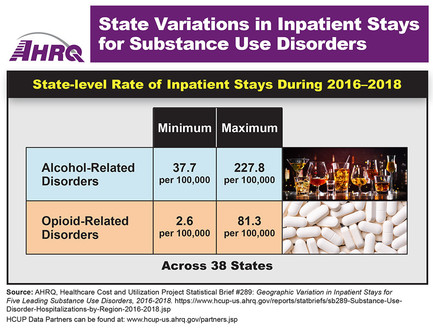| May 10, 2022, Issue #814  Access more data on this topic in the associated statistical brief, plus additional AHRQ data infographics.  In his first blog post, newly appointed AHRQ Director Robert Otto Valdez, Ph.D., M.H.S.A., endorses the agency's mission and asserts that lessons learned from the COVID-19 pandemic should guide agency efforts to improve the safety and quality of healthcare for everyone. The pandemic made clear the inequities in our society that are reflected in how healthcare is organized, financed, and provided, Dr. Valdez notes. While the pandemic accelerated the development of mRNA-based vaccines and use of telehealthcare, it also exposed inequalities in how these advances were made available in disadvantaged and rural communities. Dr. Valdez writes that President Biden's proposed FY 2023 budget would provide resources that support AHRQ's mission and priority areas while taking great strides toward addressing the challenges revealed by the pandemic. Access the blog post. |  Data collected in an electronic health record (EHR) system contained significant inaccuracies about the smoking history of thousands of patients, potentially excluding many from lung cancer screening, an AHRQ-funded study found. The study in the Journal of the American Medical Informatics Association found that more than 80 percent of nearly 17,000 health records of current and former smokers age 50 to 80 at University of Utah Health had issues including missing, outdated or inaccurate data. More than 42 percent of records contained inaccuracies on packs-per-day or years-smoked, a criterion set by the U.S. Preventive Services Task Force to recommend lung cancer screening. Researchers found that addressing these errors and others would identify nearly 50 percent more patients who were eligible for cancer screening. In addition to the most recent smoking data, they suggest that historical smoking data be made available to clinical decision support systems. Access the abstract. | A new AHRQ-funded study highlights barriers that prevent home health workers from conducting successful surveillance of central line-associated bloodstream infections (CLABSI) in patients receiving home infusion therapy. More than 3 million patients receive home and specialty infusion services per year, typically for maintenance of central lines used for chemotherapy, intravenous administration of nutrition and outpatient intravenous antimicrobial therapy. All are at high risk for developing infections. The study, published in the American Journal of Infection Control, identified eight major steps in performing CLABSI surveillance and reporting in the home infusion setting based on a series of qualitative interviews with home health agencies. The study also describes facilitators, strategies and suggestions for improving CLABSI surveillance to better track and monitor infection rates. Access the abstract.  A new grantee profile highlights the work of Barbara Yawn, M.D., M.Sc., a primary care physician working to improve health care in rural Minnesota communities. Dr. Yawn's work has focused on best practices for diagnosing and treating chronic conditions affecting women and rural residents, including coronary heart disease, postpartum depression and asthma. Through her efforts, she was able to provide primary care clinicians with resources and techniques to tailor care delivery, improving patient outcomes. She is also an adjunct professor in the Department of Family and Community Health at the University of Minnesota. Access Dr. Yawn's profile and profiles of other AHRQ grantees. |  Non-Hispanic Blacks and Hispanics increased their use of preventive services once they became eligible for Medicare benefits, according to an analysis published in the journal Preventive Medicine. Using data from the AHRQ Medical Expenditure Panel Survey's Household Component from 2005 to 2016, researchers found that Medicare coverage increased use of preventive services among the elderly in underserved populations. They studied six preventive services: blood cholesterol, colorectal cancer, and blood pressure screenings; routine checkups and mammograms (women only); and influenza vaccination rates. For example, for Hispanic respondents who reached the age of eligibility for Medicare, use of preventive services increased, including for influenza vaccinations, blood pressure screenings and mammograms. For non-Hispanic Black adults, preventive service use increased for blood cholesterol screenings, checkups in the past year and mammograms. Access the abstract. | AHRQ's Patient Safety Network (PSNet) highlights journal articles, books and tools related to patient safety. Articles featured this week include: Review additional new publications in PSNet's current issue or access recent cases and commentaries in AHRQ's WebM&M (Morbidity and Mortality Rounds on the Web). | AHRQ in the Professional Literature An exploratory study investigating the barriers, facilitators, and demands affecting caregivers in a telemedicine integrated ambulance-based setting for stroke care. Rogers H, Madathil KC, Joseph A, et al. Appl Ergon. 2021 Nov;97:103537. Epub 2021 Aug 6. Access the abstract on PubMed®. Usability barriers and facilitators of a human factors engineering-based clinical decision support technology for diagnosing pulmonary embolism. Salwei ME, Carayon P, Wiegmann D, et al. Int J Med Inform. 2021 Dec 9;158:104657. [Epub ahead of print.] Access the abstract on PubMed®. Patient engagement strategies for adults with chronic conditions: an evidence map. Aboumatar H, Pitts S, Sharma R, et al. Syst Rev. 2022 Mar 5;11(1):39. Access the abstract on PubMed®. Risk of tizanidine-induced adverse events after concomitant exposure to ciprofloxacin: a cohort study in the U.S. Giannouchos TV, Gómez-Lumbreras A, Malone DC. Am J Emerg Med. 2022 May;55:147-51. Epub 2022 Mar 10. Access the abstract on PubMed®. Screening for health-related social needs in the emergency department: adaptability and fidelity during the COVID-19 pandemic. Murray E, Roosevelt GE, Vogel JA. Am J Emerg Med. 2022 Apr;54:323.e1-.e4. Epub 2021 Oct 1. Access the abstract on PubMed®. Treatment and outcomes among patients ≥85 years hospitalized with community-acquired pneumonia. Rastogi R, Yu PC, Deshpande A, et al. J Investig Med. 2022 Feb;70(2):376-82. Epub 2021 Oct 26. Access the abstract on PubMed®. Readmission rates in stroke patients with and without infections: incidence and risk factors. Boehme AK, Oka M, Cohen B, et al. J Stroke Cerebrovasc Dis. 2022 Jan;31(1):106172. Epub 2021 Nov 16. Access the abstract on PubMed®. Delivery characteristics and the risk of early-onset neonatal sepsis. Flannery DD, Mukhopadhyay S, Morales KH, et al. Pediatrics. 2022 Feb;149(2). Access the abstract on PubMed®. Contact Information For comments or questions about AHRQ News Now, contact Bruce Seeman, (301) 427-1998 or Bruce.Seeman@ahrq.hhs.gov. |








No comments:
Post a Comment